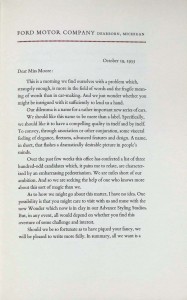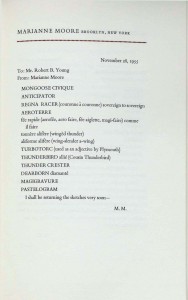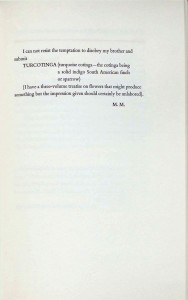[Posted by Forrest Robinette ’16, for Prof. David Rosen’s course, “Modern Poetry”]
 On October 19th in 1955, Robert B. Young, the head of the Marketing Research Department at the Ford Motor Company, sent a letter to Marianne Moore to ask if she would help the company in coming up with a name for Ford’s newest series of cars. What followed was a yearlong written correspondence between the businessman and the poet in which Moore suggested hundreds of possible names for the Ford E-car, what would eventually become the “Edsel.” Some of her suggestions include the “Ford Faberge,” the “Mongoose Civique,” the “Pluma Piluma,” the “Turcotinga,” and, perhaps the most infamous of all, the “Utopian Turtletop.” Moore and Young’s letters were collected in a book that I found during my visit to the Watkinson titled, “Letters Between Marianne Moore and the Ford Motor Company.” The book is particularly fascinating because, as the correspondence continues, we see Mr. Young realizing that he may have bitten off more than he can chew in his attempt to work with the very eccentric Moore. It is fascinating to examine how the tone of his letters change as Moore continues to send page after page of bizarre names for the Ford E-car.
On October 19th in 1955, Robert B. Young, the head of the Marketing Research Department at the Ford Motor Company, sent a letter to Marianne Moore to ask if she would help the company in coming up with a name for Ford’s newest series of cars. What followed was a yearlong written correspondence between the businessman and the poet in which Moore suggested hundreds of possible names for the Ford E-car, what would eventually become the “Edsel.” Some of her suggestions include the “Ford Faberge,” the “Mongoose Civique,” the “Pluma Piluma,” the “Turcotinga,” and, perhaps the most infamous of all, the “Utopian Turtletop.” Moore and Young’s letters were collected in a book that I found during my visit to the Watkinson titled, “Letters Between Marianne Moore and the Ford Motor Company.” The book is particularly fascinating because, as the correspondence continues, we see Mr. Young realizing that he may have bitten off more than he can chew in his attempt to work with the very eccentric Moore. It is fascinating to examine how the tone of his letters change as Moore continues to send page after page of bizarre names for the Ford E-car.
In his first letter to Moore, Young’s tone is extremely humble as he requests help on a problem that is, as he says, “more in the field of words and the fragile meaning of words than in car-making.” Young repeatedly establishes himself as Moore’s inferior on the subject of words and he holds her up as an expert. He writes, “We are seeking the help of one who knows more of this sort of magic than we.” His use of the word “magic” frames Moore’s artistic work as something that transcends the more mundane world of car-making. Young seems to be engaging in some flattery here in the hope of enlisting Moore as a consultant. Young is successful and Moore agrees to help, but he quickly runs into difficulty as he tries to establish the terms of their business relationship.
 Throughout his letters, Young repeatedly tries to settle on a method of payment for Moore’s services. At the end of his first letter he writes, “Of course, it is expected that our relations will be on a fee basis of an impeccably dignified kind.” Moore does not acknowledge this comment in her responding letter and simply says, “I am complimented to be recruited in this high matter.” Young becomes more insistent about monetary reimbursement in his second letter saying, “in compliance with procedures in this rigorous business world, I think we should make some definite arrangements for payment… before pursuing the problem further.” Moore once again fails to respond to his comment and instead responds with her first suggestion for a name, “The Silver Sword.” She then launches into a lengthy description of the Haleakalā Silversword, the rare Hawaiian plant that inspired her suggestion.
Throughout his letters, Young repeatedly tries to settle on a method of payment for Moore’s services. At the end of his first letter he writes, “Of course, it is expected that our relations will be on a fee basis of an impeccably dignified kind.” Moore does not acknowledge this comment in her responding letter and simply says, “I am complimented to be recruited in this high matter.” Young becomes more insistent about monetary reimbursement in his second letter saying, “in compliance with procedures in this rigorous business world, I think we should make some definite arrangements for payment… before pursuing the problem further.” Moore once again fails to respond to his comment and instead responds with her first suggestion for a name, “The Silver Sword.” She then launches into a lengthy description of the Haleakalā Silversword, the rare Hawaiian plant that inspired her suggestion.
 Young mentions money for a third time in his third letter to her. He writes, “It is unspeakably contrary to Procedures here to accept counsel… without a firm prior agreement of conditions (and, indeed, without a Purchase Notice).” While Young repeats himself about the issue of payment, Moore simply continues to send him fanciful suggestions for the E-car. In this third letter, Young even asks Moore to stop sending him so many suggestions. He writes, we propose “a recess in production for orderly bookkeeping.” Despite this comment, Moore continues to send letters in which she muses about the car’s name. At this point in the correspondence, it becomes clear that these individuals do not understand each other. For Young, this is his job and he intended to bring Moore on board as a paid consultant. For Moore, this is most likely a fun task that she has chosen to take on. This disparity in their objectives leads to a correspondence that is ultimately unproductive.
Young mentions money for a third time in his third letter to her. He writes, “It is unspeakably contrary to Procedures here to accept counsel… without a firm prior agreement of conditions (and, indeed, without a Purchase Notice).” While Young repeats himself about the issue of payment, Moore simply continues to send him fanciful suggestions for the E-car. In this third letter, Young even asks Moore to stop sending him so many suggestions. He writes, we propose “a recess in production for orderly bookkeeping.” Despite this comment, Moore continues to send letters in which she muses about the car’s name. At this point in the correspondence, it becomes clear that these individuals do not understand each other. For Young, this is his job and he intended to bring Moore on board as a paid consultant. For Moore, this is most likely a fun task that she has chosen to take on. This disparity in their objectives leads to a correspondence that is ultimately unproductive.
In Young’s last letter to Moore, it is clear that his attempt to utilize her help has largely failed. He writes, “contributions have been entered from many directions, and those from our “favorite Turtletopper” rate among the most interesting of all.” Note that he does not say the “best” of all. He says the most “interesting” of all. Young goes on, “We can scarcely begin to thank you for your interest… in our dilemma.” The word “interest” is particularly loaded because it would suggest that Moore approached Ford to offer suggestions when, in reality, it was Young who approached her. It seems as though Young is trying to let Moore down easy because he has realized that he cannot establish a steady or productive working relationship with her.
These letters are truly unique in how they shed light on Moore’s interactions with the non-artistic sectors of society. I do not know who chose to compile these letters in a small book, but I do know that the book is one of only five hundred and fifty copies. I imagine that this book came about because someone wanted to preserve this unique look at the personality of Marianne Moore.







